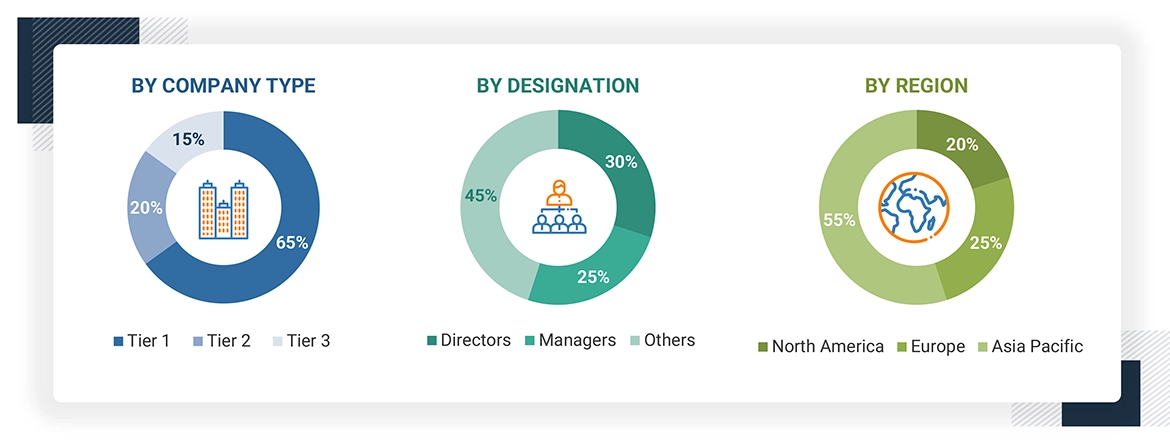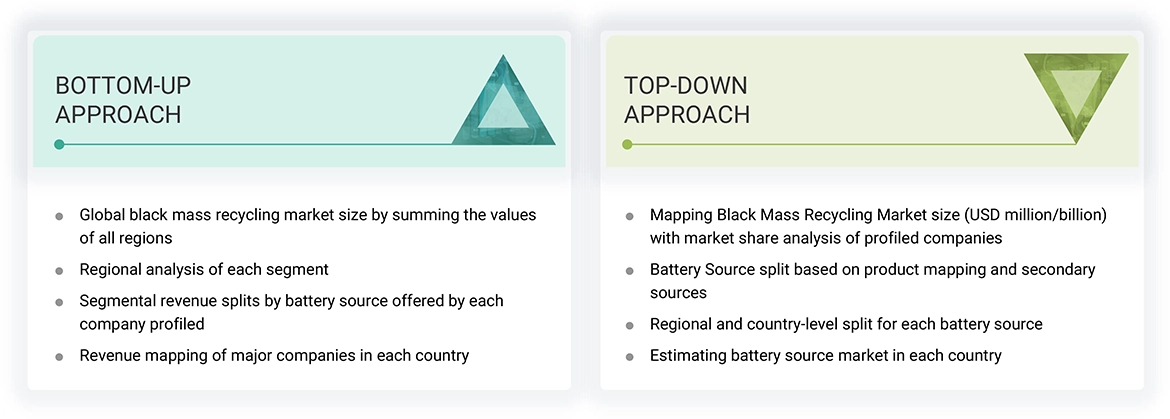The study involved four major activities in estimating the current size of the black mass recycling market. Exhaustive secondary research was done to collect information on the market, peer markets, and parent market. The next step was to validate these findings, assumptions, and sizing with the industry experts across the black mass recycling value chain through primary research. Both top-down and bottom-up approaches were employed to estimate the complete market size. Thereafter, market breakdown and data triangulation were used to estimate the market size of segments and subsegments.
Secondary Research
Secondary sources for this research study include annual reports, press releases, and investor presentations of companies; white papers; certified publications; and articles by recognized authors; gold- and silver-standard websites; black mass recycling manufacturing companies, regulatory bodies, trade directories, and databases. The secondary research was mainly used to obtain key information about the industry’s supply chain, the total pool of key players, market classification, and segmentation according to industry trends to the bottom-most level and regional markets. It has also been used to obtain information about key developments from a market-oriented perspective.
Primary Research
The black mass recycling market comprises several stakeholders, such as such as raw material suppliers, technology support providers, battery recyclers, and regulatory organizations in the supply chain. Various primary sources from both the supply and demand sides of the market were interviewed to obtain qualitative and quantitative information. Primary sources from the supply side included industry experts such as Chief Executive Officers (CEOs), vice presidents, marketing directors, technology and innovation directors, and related key executives from various key companies and organizations operating in the black mass recycling market. Primary sources from the demand side included directors, marketing heads, and purchase managers from various sourcing industries. Following is the breakdown of the primary respondents:

To know about the assumptions considered for the study, download the pdf brochure
Market Size Estimation
Both the top-down and bottom-up approaches have been used to estimate and validate the total size of the black mass recycling market. These approaches have also been used extensively to estimate the size of various dependent subsegments of the market. The research methodology used to estimate the market size included the following:
The following segments provide details about the overall market size estimation process employed in this study
-
The key players in the market were identified through secondary research.
-
The market shares in the respective regions were identified through primary and secondary research.
-
The value chain and market size of the black mass recycling market, in terms of value, were determined through primary and secondary research.
-
All percentage shares, splits, and breakdowns were determined using secondary sources and verified through primary sources.
-
All possible parameters that affect the market covered in this research study were accounted for, viewed in extensive detail, verified through primary research, and analyzed to obtain the final quantitative and qualitative data.
-
The research included the study of annual and financial reports of the top market players and interviews with industry experts, such as CEOs, VPs, directors, sales managers, and marketing executives, for key insights, both quantitative and qualitative.

Data Triangulation
After arriving at the overall market size using the market size estimation processes as explained above, the market was split into several segments and sub-segments. To complete the overall market engineering process and arrive at the exact statistics of each market segment and subsegment, the data triangulation and market breakdown procedures were employed, wherever applicable. The data was triangulated by studying various factors and trends from both the demand and supply sides in black mass recycling sector.
Market Definition
Black mass recycling refers to the process of recovering valuable materials from used batteries and battery production waste by collecting, disassembling, and crushing them into a substance known as black mass. This black mass contains critical elements, such as lithium, nickel, cobalt, and manganese, which can be extracted and reused. The importance of black mass recycling has grown as it complements the supply of raw materials while helping to reduce the carbon footprint of the battery supply chain. The growth of the industry can be attributed to the increasing environmental concerns, such as resource scarcity, and other concerns, along with a heightened focus on electronic waste management and waste reduction. Additionally, the growing demand for lithium-ion batteries in portable devices, renewable energy storage systems, and electric vehicles is creating a substantial market for advanced recycling technologies, which is, in turn, driving the black mass market.
Stakeholders
-
Raw material manufacturers
-
Technology support providers
-
Black Mass Recyclers
-
Traders, distributors, and suppliers
-
Regulatory Bodies and Government Agencies
-
Research & Development (R&D) Institutions
-
End-use Industries
-
Consulting Firms, Trade Associations, and Industry Bodies
-
Investment Banks and Private Equity Firms
Report Objectives
-
To analyze and forecast the market size of black mass recycling market in terms of value
-
To provide detailed information regarding the major factors (drivers, restraints, challenges, and opportunities) influencing the regional market
-
To analyze and forecast the global black mass recycling market on the basis of battery source, recycling process, battery type, recovered metal, and region
-
To analyze the opportunities in the market for stakeholders and provide details of a competitive landscape for market leaders
-
To forecast the size of various market segments based on three major regions: North America, Europe, and Asia Pacific, along with their respective key countries
-
To track and analyze the competitive developments, such as acquisitions, partnerships, collaborations, agreements and expansions in the market
-
To strategically profile the key players and comprehensively analyze their market shares and core competencies



Growth opportunities and latent adjacency in Black Mass Recycling Market